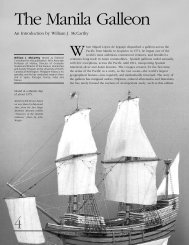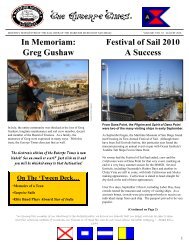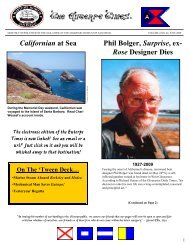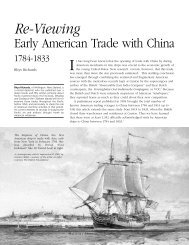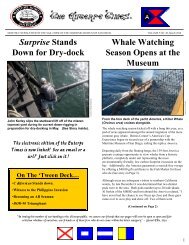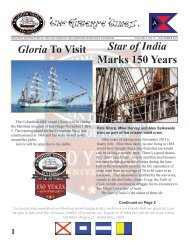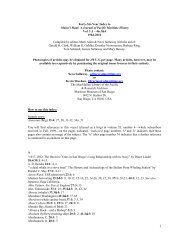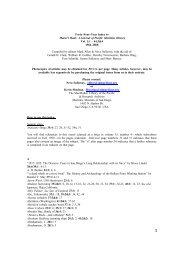Fleet Sails For Star of India! - Maritime Museum of San Diego
Fleet Sails For Star of India! - Maritime Museum of San Diego
Fleet Sails For Star of India! - Maritime Museum of San Diego
Create successful ePaper yourself
Turn your PDF publications into a flip-book with our unique Google optimized e-Paper software.
MONTHLY NEWSLETTER OF THE SAIL CREW OF THE MARITIME MUSEUM OF SAN DIEGO VOLUME 4 NO. 36, DECEMBER/JANUARY 2008-9<br />
<strong>Fleet</strong> <strong>Sails</strong> <strong>For</strong><br />
<strong>Star</strong> <strong>of</strong> <strong>India</strong>!<br />
Courtesy <strong>of</strong> Darrall Slater, www.bayshots.com<br />
Celebrating the birthday <strong>of</strong> the 1863 bark <strong>Star</strong> <strong>of</strong> <strong>India</strong>, the Lynx, Californian, HMS Surprise and Medea (not shown)<br />
set sail for the Pacific Ocean on November 15 th and 16 th .<br />
On The ‘Tween Deck…<br />
•Recounting the wreck <strong>of</strong> the Lawrence<br />
•Princess Tai Ping<br />
•Angel’s Gate Lighthouse<br />
•MMSD Takes Shape for the Future<br />
•Knots – The Sailor’s Coil<br />
<strong>For</strong> every member <strong>of</strong> the volunteer/maintenance crew at the<br />
MMSD, the month <strong>of</strong> November marks the pinnacle <strong>of</strong> the year.<br />
November marks the birth month <strong>of</strong> the <strong>Star</strong> <strong>of</strong> <strong>India</strong>, and thus,<br />
the annual voyage <strong>of</strong> the Hope Diamond <strong>of</strong> sailing, as bosun<br />
George Sutherland describes it.<br />
This year, however, as the <strong>Star</strong> <strong>of</strong> <strong>India</strong> undergoes restoration <strong>of</strong><br />
her fo'c'slehead, a fleet sailed nonetheless in honor <strong>of</strong> her 145 th<br />
birthday. On November 15th and 16th, HMS Surprise,<br />
Californian, Medea and Pilot were joined by the privateer Lynx<br />
and the Princess Tai-Ping a traditional sailing junk visiting from<br />
Hong Kong.<br />
To accommodate a large crew between the smaller vessels,<br />
crewmen were divided between sail crews per day among the<br />
(Continued on Page 2)<br />
"In issuing this number <strong>of</strong> our bantling to the Euterpe public, we assure our friends that our pages will ever be open to open and fair<br />
criticism whether <strong>of</strong> ourselves, our friends or <strong>of</strong> those few who do not come within the latter category." - Stead Ellis, 1879<br />
1
agpipes from the fore top <strong>of</strong> HMS Surprise. The haunting<br />
but beautiful tones, first heard this time last year, rippled across<br />
the still water <strong>of</strong> the bay under a setting sun.<br />
After two days <strong>of</strong> sail, the celebration <strong>of</strong> the <strong>Star</strong> <strong>of</strong> <strong>India</strong>'s 145th<br />
concluded with a pizza, beer, soda, birthday cake, very well<br />
deserved pats on the back and endless personal stories. From tea<br />
ceremonies, endless smiles, and wind-filled sail to the sound <strong>of</strong><br />
steam whistles, gunfire and repeated cheers, the museum's main<br />
event came to a close.<br />
Crew aboard HMS Surprise on the fore and mizzen<br />
mast, putting the courses and tops’ls into their gear.<br />
three ships. With the inclusion <strong>of</strong> Medea, the wealth <strong>of</strong><br />
experiences <strong>of</strong> the crew was added to as her boilers were fired up<br />
and her steam whistle sirened across the bay.<br />
Paying passengers aboard Californian and Lynx were treated to<br />
traditional seamanship, cool winds and the echo <strong>of</strong> gunfire,<br />
accompanied by borrowed guns aboard HMS Surprise.<br />
Medea and Pilot consistently accompanied the ships, recalled a<br />
period <strong>of</strong> history when steam was gradually taking over the reins<br />
<strong>of</strong> the ocean over sail. Aboard HMS Surprise, crew joined<br />
together musically with numerous instruments to pass the time<br />
away.<br />
The fleet was joined by the Princess Tai Ping on the 16th,<br />
adding to the eclectic parade <strong>of</strong> history. The Princess Tai Ping<br />
was visiting the city <strong>of</strong> <strong>San</strong> <strong>Diego</strong> in the month <strong>of</strong> November,<br />
moored to the floating barge and open to visitors. The previous<br />
day, some crew members were invited to share a traditional<br />
Chinese Tea Ceremony.<br />
Courtesy <strong>of</strong> Bert Creighton<br />
Crewmen Stan Williams and David Litzau share a tea<br />
ceremony aboard the Princess Tai Ping.<br />
No sooner had the celebration concluded than the crew were<br />
back aboard the <strong>Star</strong> <strong>of</strong> <strong>India</strong> on the following maintenance<br />
Sunday. Following repairs to the jib boom and fo'c'slehead, the<br />
<strong>Star</strong> is being restored and readied for her return next year.<br />
Following a new deck and subsequent dry-docking, the staff <strong>of</strong><br />
the museum has every intention <strong>of</strong> sailing her for her 146th<br />
birthday.<br />
Courtesy <strong>of</strong> Darrall Slater, www.bayshots.com<br />
As the sail came to a close, the crew, ships, and observers on the<br />
bay were treated to Kevin Carothers playing his now familiar<br />
Courtesy <strong>of</strong> Darrall Slater, www.bayshots.com<br />
Courtesy <strong>of</strong> Maggie Piatt-Walton<br />
Crewmen Connie Allen, Paul Wermuth, Darla Schafer<br />
and Chris Pack illustrate the endless smiles<br />
encountered through the weekend.<br />
2<br />
Medea harkens to a period when steam took over from<br />
sail as she bears down on HMS Surprise.
Photos on the page courtesy <strong>of</strong> Maggie Piatt-Walton, Darrall Slater, www.bayshots.com, Bert Creighton and Chris Lopatosky.<br />
3
Princess on a mission<br />
No bigger than a bus, Princess Tai Ping crosses the<br />
Pacific and six centuries <strong>of</strong> maritime history to<br />
prove a point<br />
Courtesy <strong>of</strong> The <strong>San</strong> <strong>Diego</strong> Union-Tribune<br />
November 22 nd 2008<br />
There's an elegant piece <strong>of</strong> Ming Dynasty-style artwork moored<br />
at the <strong>San</strong> <strong>Diego</strong> <strong>Maritime</strong> <strong>Museum</strong>.<br />
Don't underestimate her.<br />
Roughly the size <strong>of</strong> a <strong>San</strong> <strong>Diego</strong> city bus, or about one-fourth <strong>of</strong><br />
the length <strong>of</strong> the neighboring ship <strong>Star</strong> <strong>of</strong> <strong>India</strong>, the 15th century<br />
style Chinese junk Princess Tai Ping has just sailed across<br />
thousands <strong>of</strong> miles <strong>of</strong> northern Pacific Ocean and transcended six<br />
centuries <strong>of</strong> history to prove a point.<br />
Angela Chao, the Princess Tai Ping's lone female crew<br />
member, greets visitors with tea and warm hospitality.<br />
Living for many weeks at a time without touching land requires<br />
unusual closeness and resourcefulness, especially when<br />
replicating history is part <strong>of</strong> your mandate.<br />
The crew members catch their own fish, and sometimes collect<br />
rainwater for washing. They use ancient methods to preserve<br />
chicken eggs and other perishables, much as their counterparts<br />
did some 600 years ago. Down time at sea is filled with watching<br />
marine life, reading, storytelling, writing, and other gadget-free<br />
activity.<br />
There's no plumbing. A tiny enclosed privy is located aft, and it's<br />
as basic as can be. Showers and laundry are generally<br />
accomplished via buckets <strong>of</strong> seawater. The sailors demonstrated<br />
the bucket-shower technique and explained how they rig a<br />
privacy curtain – a slight departure from tradition, but essential<br />
under the circumstances.<br />
The Chinese junk Princess Tai Ping is tied up at the<br />
<strong>Maritime</strong> <strong>Museum</strong> on the Embarcadero, tentatively<br />
through Thanksgiving, Nov. 27 and is open to visitors.<br />
Like Thor Heyerdahl's celebrated 1947 Kon-Tiki expedition, this<br />
voyage has attempted to show that the ancient mariners did have<br />
the knowledge and skills to cross the Pacific Ocean.<br />
The 54-foot, 35-ton Fujien-style warship is following the<br />
conjectured route <strong>of</strong> 15th century Chinese admiral and explorer<br />
Zhang He, who, according to theory, may have arrived on the<br />
North American West Coast long before Cabrillo.<br />
Zhang He would have sailed in exactly this type <strong>of</strong> small warship<br />
to do it.<br />
Visitors are welcomed with warm smiles and hot green tea, and<br />
invited to explore the tiny, colorful vessel.<br />
On a recent day, laundry was strung in the rigging, and supplies<br />
crowded every little cubbyhole on deck. The ship seems<br />
impossibly small to have carried eight people so far for so many<br />
months, yet the banter among the crew is lively and funny with<br />
no signs <strong>of</strong> shipmate fatigue.<br />
Sleeping bunks are a tight squeeze, but the accommodations are<br />
surprisingly cozy unless a storm sloshes water below deck.<br />
A wild storm at sea prevented their arrival in Seattle but bonded<br />
the crew even more closely. The sailors speak <strong>of</strong> huddling<br />
together in their raincoats to stay warm in such conditions,<br />
although it doesn't necessarily keep them dry.<br />
The vessel departed Xiamen, China in April 2008, with stops in<br />
Hong Kong, Taiwan and Japan.<br />
It took nearly 70 days to make the trip from Osaka to <strong>San</strong><br />
Francisco. The Princess Tai Ping arrived in <strong>San</strong> <strong>Diego</strong> on Nov.<br />
13. The next leg, from <strong>San</strong> <strong>Diego</strong> to Hawaii, is anticipated to<br />
take one month.<br />
The ship will make a return visit to Japan and be back in Taiwan<br />
sometime in April 2009 – all dependent on the winds and<br />
currents.<br />
4
New Tools <strong>For</strong> Education<br />
Over 13,000 volunteer hours<br />
this year. You folks are<br />
amazing!!<br />
~ Peter Durdaller, Ships Operations<br />
Reefing Tops’ls<br />
Courtesy <strong>of</strong> Connie Allen<br />
November 7th marks the first Californian Challenge sail to use<br />
this very special equipment. Students from Monarch must earn<br />
the privilege <strong>of</strong> firing the great gun by completing the puzzle.<br />
Participants earn puzzle pieces through developing the skills and<br />
attitude necessary to sail a ship. Lori Davis put her artistic talents<br />
to use creating this beautiful and useful tool.<br />
During sail training in October, the crew <strong>of</strong> HMS<br />
Surprise experienced a rare aspect <strong>of</strong> sail training in<br />
reefing tops’ls. Shown here, both the fore and main<br />
tops’ls are triple-reefed.<br />
~ Connie Allen, Californian Educational Coordinator<br />
CREW<br />
DINNER!<br />
The annual sail crew dinner has been tentatively set<br />
for Friday, January 30th aboard the Berkeley. The<br />
event begins at 6:30PM and ends “when the well runs<br />
dry”. Dinner and desert will be served and a hosted<br />
bar (sorry, no appetizers).<br />
Each crew member is allowed to bring one guest. Mr.<br />
Davis has asked for RSVPs if you can attend this<br />
event. Please include whether you plan on bringing a<br />
guest.<br />
Thank you.<br />
5
Get Off My Ship!<br />
Sci-Fi Channel’s Ghost Hunters Visits MMSD<br />
Early November saw the national broadcast <strong>of</strong> "Spirits on the<br />
Water," and episode <strong>of</strong> Sci-Fi Channel's series Ghost Hunters.<br />
Featuring a paranormal investigation into the museum's<br />
longstanding folklore aboard the museum's oldest vessels.<br />
One notable exception was the <strong>Star</strong> <strong>of</strong> <strong>India</strong>. Aboard the <strong>Star</strong>,<br />
many occurrence were not explained by any natural<br />
phenomenon. Surprisingly as well, digital audio revealed to the<br />
surprise <strong>of</strong> First Mate Jim Davis, a voice apparently threatening,<br />
"Get <strong>of</strong>f my ship."<br />
TAPS member conduct an overnight investigation on<br />
the ‘tween deck <strong>of</strong> the <strong>Star</strong> <strong>of</strong> <strong>India</strong> using a multitude <strong>of</strong><br />
sensory equipment.<br />
Jason Hawes and Grant Wilson <strong>of</strong> The Atlantic Paranormal<br />
Society, or TAPS, and their crew arrived in <strong>San</strong> <strong>Diego</strong> in the<br />
month <strong>of</strong> September. Over a two day period, the group<br />
conducted investigations on board the <strong>Star</strong> <strong>of</strong> <strong>India</strong> and Berkeley.<br />
From unexplained footsteps, to cold spots, and apparitions, the<br />
team had plenty <strong>of</strong> leads to investigate.<br />
John Merrill speaks <strong>of</strong> his paranormal encounters in<br />
the salon on <strong>Star</strong> <strong>of</strong> <strong>India</strong>.<br />
The investigation into the museum's ships are the second <strong>of</strong> note<br />
in the past 2 years. It was reported in October (Volume 3,<br />
Number 34) <strong>of</strong> Pacific Paranormal Investigations, whose<br />
investigations led to similar conclusion aboard the <strong>Star</strong> <strong>of</strong> <strong>India</strong>.<br />
Staff member David Burgess discusses unseen<br />
footsteps to a nationwide audience.<br />
One difficulty experience by the team is the fact that ships are<br />
exposed to a wealth <strong>of</strong> external elements including wave action<br />
and sea life. Although most experiences could not be completely<br />
explained away, it would seem that these would have a tendency<br />
to explain some <strong>of</strong> the various reports.<br />
Jason Hawes and Grant Wilson reveal to Jim Davis the<br />
audio recording purporting to say, “Get <strong>of</strong>f my ship.”<br />
The episode was first broadcast in early November and can be<br />
currently seen in reruns on the Sci-Fi Channel. The <strong>Museum</strong> as<br />
a whole has received more exposure to the general public. In<br />
addition to our notable ships, its notable ghosts are now a source<br />
<strong>of</strong> its draw as a whole.<br />
6
Pablo’s Fo’c’sle<br />
The sheets were frozen hard, and they cut the naked hand;<br />
The decks were like a slide, where a seaman scarce could stand,<br />
The wind was a nor'-wester, blowing squally <strong>of</strong>f the sea;<br />
And cliffs and spouting breakers were the only things a-lee.<br />
They heard the surf a-roaring before the break <strong>of</strong> day;<br />
But 'twas only with the peep <strong>of</strong> light we saw how ill we lay.<br />
We tumbled every hand on deck instanter, with a shout,<br />
And we gave her the maintops'l, and stood by to go about.<br />
All day we tack'd and tack'd between the South Head and the<br />
North;<br />
All day we haul'd the frozen sheets, and got no further forth;<br />
All day as cold as charity, in bitter pain and dread,<br />
<strong>For</strong> very life and nature we tack'd from head to head.<br />
We gave the South a wider berth, for there the tide-race roar'd;<br />
But every tack we made we brought the North Head close<br />
aboard;<br />
So's we saw the cliffs and houses, and the breakers running<br />
high,<br />
And the coastguard in his garden with his glass against his eye.<br />
The frost was on the village ro<strong>of</strong>s as white as ocean foam;<br />
The good red fires were burning bright in every 'longshore home;<br />
The windows sparkled clear, and the chimneys volley'd out;<br />
And I vow we sniff'd the victuals as the vessel went about.<br />
Christmas at Sea<br />
They lit the high sea-light, and the dark began to fall.<br />
'All hands to loose topgallant sails!' I heard the captain call.<br />
'By the Lord, she'll never stand it,' our first mate Jackson<br />
cried.<br />
. . . 'It's the one way or the other, Mr. Jackson,' he replied.<br />
She stagger'd to her bearings, but the sails were new and good,<br />
And the ship smelt up to windward just as though she<br />
understood.<br />
As the winter's day was ending, in the entry <strong>of</strong> the night,<br />
We clear'd the weary headland, and pass'd below the light.<br />
And they heaved a mighty breath, every soul on board but me,<br />
As they saw her nose again pointing handsome out to sea;<br />
But all that I could think <strong>of</strong>, in the darkness and the cold,<br />
Was just that I was leaving home and my folks were growing<br />
old.<br />
~ Robert Louis Stevenson<br />
And they heaved a mighty breath, every soul on board but me,<br />
As they saw her nose again pointing handsome out to sea;<br />
But all that I could think <strong>of</strong>, in the darkness and the cold,<br />
Was just that I was leaving home and my folks were growing<br />
old.<br />
~ Robert Louis Stevenson<br />
The bells upon the church were rung with a mighty jovial cheer;<br />
<strong>For</strong> it's just that I should tell you how (<strong>of</strong> all days <strong>of</strong> the year)<br />
This day <strong>of</strong> our adversity was blessed Christmas morn,<br />
And the house above the coastguard's was the house where I was<br />
born.<br />
O well I saw the pleasant room, the pleasant faces there,<br />
My mother's silver spectacles, my father's silver hair;<br />
And well I saw the firelight, like a flight <strong>of</strong> homely elves<br />
Go dancing round the china-plates that stand upon the shelves!<br />
And well I knew the talk they had, the talk that was <strong>of</strong> me,<br />
Of the shadow on the household and the son that went to sea;<br />
An O the wicked fool I seem'd, in every kind <strong>of</strong> way,<br />
To be here and hauling frozen ropes on blessed Christmas Day.<br />
Mr. Weigelt’s <strong>Maritime</strong> Dictionary<br />
LINSTOCK, (boute-feu, ou baton a meche, Fr.) a<br />
staff about three feet long, having a sharp point at one<br />
end, and a sort <strong>of</strong> fork or crotch on the other; the latter<br />
serves to contain a lighted match, and, by the former, the<br />
linstock is occasionally stuck in the deck, in an upright<br />
position. It is frequently used in small vessels, in an<br />
engagement, where there is commonly one fixed between<br />
every two guns, by which the match is always kept dry<br />
and ready for firing.<br />
7
Concept to Reality:<br />
The <strong>Museum</strong>’s Future Takes Shape<br />
Conceptual artwork <strong>of</strong> the future MMSD illustrates the north side <strong>of</strong> the Berkeley.<br />
As December appeared quickly on the setting <strong>of</strong> the November<br />
sail, staff and volunteers eagerly immersed themselves into the<br />
new task at hand, the new year.<br />
That new year, isn't one <strong>of</strong> tradition rather, a starting point to the<br />
long anticipated expansion <strong>of</strong> the museum. It started during the<br />
summer as the floating dock "Big Blue" finally arrived,<br />
expanding the mooring and display footage.<br />
Small craft such as Wings, Butcher Boy and the Monterey Boats<br />
were moved from the Embarcadero to the dock in October. The<br />
dock has already hosted tall ships during the 2008 Sail Festival<br />
and longer stays by both the H.M.A.V. Bounty and privateer<br />
Lynx.<br />
With these new avenues <strong>of</strong> visitor opportunities, crew and staff<br />
set about working on refurbishment <strong>of</strong> the aft end <strong>of</strong> the<br />
Berkeley, typically used as an extension <strong>of</strong> the machine/wood<br />
shop.<br />
The current work simply adds to the excitement and anticipation<br />
<strong>of</strong> what come next, then next again. Work on the U.S.S. Dolphin<br />
is quickly finishing up on entry and exit ways, making ready for<br />
her arrival at the museum early in 2009.<br />
Additionally, a new relationship with Dennis Connor and the<br />
replica <strong>of</strong> the 1851 yacht America places a new schooner at the<br />
museum temporarily beginning in January.<br />
<strong>San</strong>ding, painting, new ironwork aboard Berkeley are enhanced<br />
by the construction <strong>of</strong> a new gangway leading aboard the<br />
floating barge. The crew has already discovered the ongoing<br />
effort <strong>of</strong> bird droppings that may rival the continual painting and<br />
scrapping <strong>of</strong> the B-39 submarine.<br />
The expansion <strong>of</strong> the museum is only hinted at by these<br />
developments. They provide not just more exhibit space, but a<br />
launching pad for the museum's unique effort, the "<strong>Museum</strong><br />
Underway Initiative."<br />
Conceptual artwork becomes reality with the addition <strong>of</strong> the floating barge in Fall <strong>of</strong> 2008.<br />
8
Further Reading<br />
Randy Ashman directs John McClure in the<br />
construction <strong>of</strong> a new gangway leading from the<br />
Berkeley to the floating barge.<br />
As reported on in November, the tops'l schooner Californian and<br />
HMS Surprise will be joined in a 3-pronged floating museum<br />
program by the <strong>San</strong> Salvador. These ships will carried aboard<br />
not only crew, but traveling exhibits and specialized educational<br />
programs, possibly as far north as <strong>San</strong> Francisco and<br />
Sacramento.<br />
<strong>For</strong> HMS Surprise, her role will expand to not only a museum<br />
afloat, but a traditional seamanship school. Originally as HMS<br />
Rose, she was the first Class-A size Sailing School Vessel in the<br />
United States. The museum is currently making every effort to<br />
restore this unique certification.<br />
Discussed in detail in the latest issue <strong>of</strong> Full & By, the museum's<br />
quarterly membership journal, the construction <strong>of</strong> <strong>San</strong> Salvador<br />
will occur near Spanish Landing. The construction will have<br />
public access serving as "a showcase for historic ship<br />
construction methods." This satellite museum will certainly<br />
serve to increase exposure to the public.<br />
The Summer/Fall issue <strong>of</strong> Full & By (Vol. 19 No.3) contains indepth<br />
information on the construction <strong>of</strong> <strong>San</strong> Salvador, the<br />
<strong>Museum</strong> Underway Initiative and coverage <strong>of</strong> the 2008 Festival<br />
<strong>of</strong> Sail.<br />
MISSED A EUTERPE<br />
TIMES?<br />
The Euterpe Times is available in several formats,<br />
paper or digital, or Cd-Rom.<br />
Each Cd-Rom will include all issues up to the<br />
current date.<br />
Just ask, find Brad on the deck or at<br />
euterpetimes@yahoo.com<br />
Volunteer Carl Carrano preps the aft end <strong>of</strong> the<br />
Berkeley for new paint.<br />
9
A Fight to Save a Light<br />
Los Angeles YC spearheads effort to<br />
preserve and restore historic Angel’s Gate.<br />
Courtesy <strong>of</strong> The Log November 6 th , 2008<br />
SAN PEDRO -- Los Angeles Harbor’s iconic Angel’s Gate<br />
Lighthouse is much more than a venerable aid to navigation, say<br />
proponents <strong>of</strong> a new plan to restore the historic structure that<br />
marks the entrance to the Port <strong>of</strong> Los Angeles.<br />
Angel’s Gate Lighthouse was built in 1913 at the end <strong>of</strong> a 9,250-<br />
foot rock breakwater, on a 40-foot concrete foundation <strong>of</strong>f<br />
Cabrillo Beach. Designed in eye-catching Romanesque style,<br />
different from any other lighthouse in the state, this 73-foot<br />
tower was built to withstand continual punishment from rough<br />
seas and heavy weather -- and underneath its elegant exterior is a<br />
framework <strong>of</strong> sturdy structural steel.<br />
the harbor.”<br />
The Los Angeles YC proposal requests funding from the Port’s<br />
Aesthetic Mitigation Fund to pay for the necessary restoration,<br />
with preliminary estimates <strong>of</strong> $1.5 million to $2 million. The<br />
fund was set in place to ease any burden experienced by local<br />
boaters and residents resulting from the port’s commercial<br />
success. This lighthouse restoration project represents an ideal<br />
opportunity to use these funds in a way that benefits not only<br />
West Coast boaters, but all citizens <strong>of</strong> California, Wallace<br />
explained.<br />
“This is the historical icon for the Port <strong>of</strong> Los Angeles,” Wallace<br />
said. “And if we take care <strong>of</strong> it, we can ensure another 100 years<br />
<strong>of</strong> service.”<br />
<strong>For</strong> more information, visit the Los Angeles YC Web site, at<br />
www.layc.org, and click on “Support the Angel’s Gate<br />
Lighthouse.”<br />
10<br />
Angel’s Gate has become a symbol <strong>of</strong> Los Angeles Harbor and a<br />
welcoming sight to millions <strong>of</strong> arriving recreational boaters,<br />
cruise ship passengers, fishermen and Navy personnel, said<br />
Barbara Wallace, historian for Los Angeles Yacht Club.<br />
However, over its nearly 100 years <strong>of</strong> service, the lighthouse has<br />
endured tremendous storms and earthquakes, and it has gradually<br />
fallen into disrepair, leaving the structure compromised.<br />
While it is operated and maintained by the Coast Guard, the<br />
agency’s responsibility and funding only ensures that the<br />
navigation light and foghorn will remain operative and in<br />
compliance with federal rules.<br />
Preservation <strong>of</strong> this piece <strong>of</strong> maritime history is extremely<br />
important, -- and harbor boaters should realize that if the present<br />
structure fails, it will be replaced with a less expensive, purely<br />
functional, modern skeleton-framed structure that will likely be<br />
unattractive, Wallace said.<br />
Because <strong>of</strong> the importance <strong>of</strong> avoiding this loss, Los Angeles<br />
Yacht Club is spearheading a project to ensure restoration <strong>of</strong><br />
Angel’s Gate Lighthouse.<br />
“Ours is one <strong>of</strong> the biggest ports in the nation, and we want to be<br />
proud <strong>of</strong> the entrance to our harbor and show people that we take<br />
care <strong>of</strong> our heritage,” said Wallace, who created the proposal for<br />
the Angel’s Gate Lighthouse Restoration Project. “This is really<br />
the first historic landmark that people see when they come into<br />
Courtesy <strong>of</strong> James Longton<br />
The Angel’s Gate lighthouse is seen towards the left as<br />
HMS Surprise entered the harbor at <strong>San</strong> Pedro in<br />
August.<br />
Again the New Ferry<br />
Wharf Destroyer<br />
Berkeley Open War on<br />
the Piles <strong>of</strong> Her Slip.<br />
The new ferry boat Berkeley had another set-to with her slippiles<br />
Saturday night. She was coming in with a huge load <strong>of</strong><br />
passengers about 8 o'clock, and on nearing the landing on this<br />
side the passengers crowded on to the forward end <strong>of</strong> the boat.<br />
This lifted the after end, hoisting the then acting rudder<br />
sufficiently out <strong>of</strong> the water to render the vessel unmanageable.<br />
She ducked her head low like an enraged bull and charged the<br />
outer point <strong>of</strong> the slip, clipping about a dozen piles <strong>of</strong>f close to<br />
the water's edge.<br />
Courtesy <strong>of</strong> the <strong>San</strong> Francisco Call., December 5 th , 1898.<br />
Courtesy <strong>of</strong> Brad Holderman
A Few More Knots –<br />
The Sailor’s Coil<br />
The sailor’s coil (Ashley<br />
Book <strong>of</strong> Knots #3098) is<br />
a simple, secure coil for<br />
stowing down lines. It’s<br />
quickly made and<br />
withstands rough<br />
handling. It’s also<br />
convenient for coiling<br />
small stuff.<br />
Make an ordinary right<br />
hand coil, then use the<br />
end to make a single hitch<br />
around the coil (Fig. 1).<br />
Make a second hitch on<br />
the left (Fig. 2) and<br />
tighten the hitches (Fig.<br />
3). The completed hitch<br />
around the coil (Fig. 4)<br />
slightly resembles a clove<br />
hitch, but is actually a<br />
reversed ground line<br />
hitch.<br />
If the coil is to be hung,<br />
the end can be left long.<br />
Sometimes it’s<br />
convenient to use a bight<br />
to make the hitches so<br />
that a loop is created (Fig.<br />
5).<br />
NOTE: This is optional<br />
material. It is not on the<br />
list <strong>of</strong> basic knots that<br />
<strong>Maritime</strong> <strong>Museum</strong> sailors<br />
are required to know.<br />
Before you spend any<br />
time learning this knot,<br />
make sure that you are<br />
completely confident <strong>of</strong> your ability to tie the required basic<br />
knots, which include the bowline, figure eight knot, square<br />
knot, clove hitch, two half hitches and stopper hitch. First<br />
things first!<br />
~ David S. Clark – MMSD Volunteer Crew<br />
Dennis Conner, <strong>Museum</strong><br />
Offer Whale Cruises<br />
Aboard America Replica<br />
Courtesy <strong>of</strong> The Log November 6th, 2008<br />
SAN DIEGO (AP) — Dennis Conner has encountered whales<br />
while training for the America’s Cup and sailing around the<br />
world.<br />
Now, a company co-owned by the four-time America’s Cup<br />
champion is partnering with the <strong>Maritime</strong> <strong>Museum</strong> <strong>of</strong> <strong>San</strong> <strong>Diego</strong><br />
to <strong>of</strong>fer “green” whale-watching cruises aboard a replica <strong>of</strong> the<br />
boat that gave sailing’s biggest and oldest competition its name.<br />
The daily four-hour cruises aboard the 139-foot schooner<br />
America began Dec. 27 and run through the end <strong>of</strong> March,<br />
allowing passengers a look at gray whales as they migrate south.<br />
“If you want to go on the water, this is a fun way to do it,<br />
because you get to ride on the America and you get to see the<br />
whales as a bonus,” Conner said.<br />
Conner has partnered with Troy Sears in Dennis Conner’s<br />
America’s Cup Experience, which <strong>of</strong>fers rides on America and<br />
two America’s Cup sloops from the 1990s.<br />
Conner and Sears said whales don’t feel as threatened by<br />
sailboats as they might by diesel-powered boats.<br />
“These guys have great hearing, much like dogs. If you’re out<br />
there in a sailboat that’s going along, they’re not frightened, so<br />
they come up alongside,” Conner said.<br />
“America’s got low freeboard, so you feel like you’re right next<br />
to them -- as opposed to being up in a big power launch.”<br />
Plus, wind power is cleaner than diesel power, Conner said.<br />
Weekend rates are $85 for adults and $44 for children 12 and<br />
under. Weekday rates are $65 for adults and $34 for children.<br />
Prices include admission to the <strong>Maritime</strong> <strong>Museum</strong>. The cruises<br />
leave from the <strong>Maritime</strong> <strong>Museum</strong> on <strong>San</strong> <strong>Diego</strong> Bay.<br />
Courtesy <strong>of</strong> Darrall Slater, www.bayshots.com<br />
11
Falls <strong>of</strong> Clyde requests<br />
return <strong>of</strong> artifacts<br />
SS Catalina is seaworthy<br />
no more<br />
The once-proud steamship, which ferried millions<br />
<strong>of</strong> passengers to the island town <strong>of</strong> Avalon, is being<br />
cut for scrap after sitting for years in Ensenada<br />
harbor.<br />
The de-masted Falls <strong>of</strong> Clyde is ready for towing to<br />
drydock.<br />
Courtesy <strong>of</strong> David Litzau<br />
Distributed through the internet via news items and tall ship<br />
posts, the Friends <strong>of</strong> the Falls <strong>of</strong> Clyde announced a search for<br />
items removed from the Falls <strong>of</strong> Clyde.<br />
Please return our artifacts!<br />
Recent inspection <strong>of</strong> the Falls <strong>of</strong> Clyde has shown that she is<br />
missing many artifacts such as skylights and portholes. The<br />
Friends <strong>of</strong> Falls <strong>of</strong> Clyde is requesting that these artifacts be<br />
returned to the ship to help with her preservation and<br />
restoration.<br />
Please contact Keven Williamson<br />
(kwilliamson@friends<strong>of</strong>falls<strong>of</strong> clyde.org) or Heather McGregor<br />
(hmcgregor@friends<strong>of</strong> falls<strong>of</strong>clyde.org OR tel: 526-1559 and<br />
leave a message) if you wish to return anything.<br />
Heather will also pick up artifacts if you leave her your address.<br />
Many thanks to the folks who have stepped up to preserve a part<br />
<strong>of</strong> the Falls <strong>of</strong> Clyde while she was going through difficult times.<br />
Crewman David Litzau recently was in Hawaii and stopped by<br />
the Falls <strong>of</strong> Clyde. As David describes her condition, “She has<br />
had all the topmasts removed and all yards and masts are on the<br />
deck. The topside deck was in bad enough shape that I wasn't<br />
even comfortable walking on it. The hull appears to be having<br />
trouble keeping rivets.”<br />
David had the pleasure <strong>of</strong> an un<strong>of</strong>ficial tour <strong>of</strong> the Falls <strong>of</strong> Clyde<br />
by the name <strong>of</strong> Don, her longstanding caretaker and one-man<br />
army. “It seems he had been working on the FoC for the last 17<br />
years and has had to watch the money, volunteers, interest, and<br />
health <strong>of</strong> the ship deteriorate to its present condition…He was<br />
clearly sad to see her go.”<br />
The SS Catalina rusting away in Ensenada Harbor in<br />
2003. The steamship was to have been converted into a<br />
tourist attraction, but the plan foundered.<br />
By Bob Pool Courtesy <strong>of</strong> The Los Angeles Times<br />
January 8 th 2009<br />
In the end, the Great White Steamer was a great white elephant.<br />
The island town <strong>of</strong> Avalon didn't want the SS Catalina, which for<br />
50 glorious years ferried about 25 million people to its shores.<br />
Neither did the Port <strong>of</strong> Los Angeles, or harbors in <strong>San</strong> <strong>Diego</strong>,<br />
Vancouver and Honolulu. And, finally, neither did the Port <strong>of</strong><br />
Ensenada.<br />
That's why Mexican demolition workers are putting an end to a<br />
three-decade campaign to preserve the once-proud steamship by<br />
cutting the 302-foot vessel apart for scrap.<br />
"It's just horrible, they're demolishing her as we speak," said<br />
David Engholm, who was a fan <strong>of</strong> the Catalina as a boy, met his<br />
wife because <strong>of</strong> the ship and finally was married on its deck<br />
nearly 20 years ago.<br />
"We tried so hard to save her," he said. "Half <strong>of</strong> her funnel was<br />
still on the ship last month, but now it's gone. It's very sad."<br />
Built at a cost <strong>of</strong> $1 million by onetime Catalina Island owner<br />
and chewing gum mogul William Wrigley, the SS Catalina plied<br />
the ocean between Wilmington and Avalon daily between 1924<br />
and 1975.<br />
Along with a 26-mile ocean voyage, a $2.25 round-trip ticket<br />
<strong>of</strong>fered 2,200 passengers big-band orchestra music for dancing,<br />
children's entertainment by clowns and magicians, and adult<br />
amenities such as a leather settees and drinks from a shipboard<br />
bar.<br />
12
SS Catalina (cont)<br />
Smaller, faster ferries connecting the mainland and the island<br />
eventually spelled doom for the huge steamship, known for its<br />
crisp white paint job and deep, melodious horn that announced<br />
its departure.<br />
Its arrival in Avalon would be heralded by circling speedboats.<br />
Children would dive into the water for coins tossed over the rail<br />
by passengers as island townspeople sang to passengers walking<br />
down the 25-foot gangplanks.<br />
"They were probably poor kids trying to make a buck," former<br />
passenger Dorothy Weil <strong>of</strong> Bel-Air recalled Monday. Although<br />
she was too young to drink at the ship's bar, there was dancing to<br />
its orchestra -- an unforgettable experience for a teenager in the<br />
1940s.<br />
During World War II, the 1,766-ton vessel with its twin 2,000-<br />
horsepower engines and football-field-size steel decks was used<br />
as a military transport. It carried 820,199 troops around <strong>San</strong><br />
Francisco Bay before being returned to Los Angeles.<br />
As it continued its island runs, the ocean cruise-like ship was<br />
designated a Los Angeles historical cultural landmark and a state<br />
historical landmark and placed on the National Register <strong>of</strong><br />
Historic Places.<br />
But after its retirement following its 9,807th Catalina Channel<br />
crossing, the ship passed through several hands and sat unused<br />
for two years before a Beverly Hills developer purchased it as a<br />
Valentine's Day gift for his wife at an auction. Hymie Singer's<br />
$70,000, spur-<strong>of</strong> the-moment purchase came after the couple's<br />
32-foot cabin cruiser sank.<br />
Ballooning dockage fees forced Singer to move the Catalina<br />
from the <strong>San</strong> Pedro area to Newport Beach, <strong>San</strong> <strong>Diego</strong>, <strong>San</strong>ta<br />
Monica Bay and Long Beach.<br />
A 1983 plan to rehabilitate the ship and return it to island service<br />
failed. The unmanned ship twice broke loose from its moorings<br />
<strong>of</strong>f Long Beach. On the first unauthorized jaunt, it ran aground.<br />
On the second, in 1985, it nearly collided with the tanker Exxon<br />
Washington before taken into tow by a tugboat that just<br />
happened to be in the area.<br />
When the Coast Guard announced plans to seize the ship, its<br />
owner had it towed to Mexican waters, where it was promptly<br />
confiscated.<br />
The 302-foot SS Catalina, shown here at Avalon in<br />
1929, is being cut up for scrap.<br />
Many <strong>of</strong> those who have watched the steamship's sad decline and<br />
rusty descent into the mud <strong>of</strong> Ensenada's harbor suggest that it<br />
sank because <strong>of</strong> water that leaked in through seals used to plug<br />
the propeller openings. Others blame damage by thieves who<br />
have looted other equipment from the ship's engine room.<br />
Engholm is a 44-year-old property manager who lives in Coos<br />
Bay, Ore. He met his wife-to-be while visiting Ensenada to see<br />
his favorite steamship's renovation into a tourist attraction. They<br />
married aboard the moored vessel in 1989.<br />
The Engholms have salvaged some <strong>of</strong> the Catalina's original<br />
lighting fixtures, benches and cushioned seats for their home --<br />
as well as one <strong>of</strong> its 2 1/2 -ton gangplanks. They also have a<br />
huge collection <strong>of</strong> photos and other memorabilia from its ferry<br />
days.<br />
Among David's prizes is an audiotape <strong>of</strong> the ship sounding its<br />
horn and the orchestra playing "Avalon" as it pulled out <strong>of</strong><br />
Catalina's harbor. Engholm taped it on a small cassette recorder<br />
in 1973.<br />
"I tried to save the pilot house. But the demolition company<br />
didn't get the word in time and tore it <strong>of</strong>f the ship," Engholm<br />
said.<br />
"I'm happy to show people the collection. If you're in Coos Bay,<br />
just give me a call. I'm listed."<br />
It was later towed into the Ensenada harbor, where developers<br />
announced plans to convert the Catalina into a floating tourist<br />
attraction with shops, a restaurant and a disco after authorities<br />
released it.<br />
That plan foundered and the ship fell into further disrepair. After<br />
its solid bronze propellers were removed as part <strong>of</strong> a<br />
governmental requirement that stripped active registration from<br />
vessels unable to move under their own power, the Catalina<br />
began to sink.<br />
13
The Wreck <strong>of</strong> the U.S.<br />
Brig Lawrence<br />
THE WRECK OF THE U.S. BRIG LAWRENCE. - We have<br />
been kindly furnished by a friend who was an <strong>of</strong>ficer on board<br />
the Lawrence at the time <strong>of</strong> her wreck, with the following<br />
detailed description <strong>of</strong> the disaster:<br />
"At 7 P.M. on the evening <strong>of</strong> the 25th calm.<br />
Came to an anchor on the Bar, <strong>of</strong>f <strong>San</strong> Francisco, in five fathoms<br />
water, and took bearings <strong>of</strong> the entrance. The North Head bore<br />
N.E. by N.; the South Head, E.S.E.; the sea breaking all around<br />
us, and a strong current setting to the southward, keeping the<br />
vessel broadside to the sea. Two topping seas having already<br />
boarded us, there was great danger <strong>of</strong> having the decks swept.<br />
The vessel first struck in 3 1/2<br />
fathoms water, and in the next<br />
breaker came down with such<br />
tremendous force, that it appeared as<br />
if every seam and timer in her must<br />
have started.<br />
Commenced heaving in chain, to change our position. At 8:30,<br />
P.M., parted the cable. We were then driven in a direction that<br />
Capt. Ottinger and myself judged to be towards the shoal water<br />
on the Bar, our intention being to get the vessel over the breakers<br />
and anchor inside in deep water, where we could ride in safety;<br />
but, being much closer to the shore than we judged, the ship was<br />
in the breakers, near the beach, before we could distinguish<br />
between them and those that were foaming in every direction<br />
around us. When the chain parted, the vessel's head pad <strong>of</strong>f from<br />
N.W. to W. by S., and drifted directly astern, making an E. by N.<br />
course, which from the bearings, should have carried us in nearly<br />
mid-channel. The vessel first struck in 3 1/2 fathoms water, and<br />
in the next breaker came down with such tremendous force, that<br />
it appeared as if every seam and timer in her must have started.<br />
At the same time, tons <strong>of</strong> water fell upon our decks. By<br />
changing the position <strong>of</strong> the sails, the ship's head was kept<br />
toward the beach, and stern to the breakers. We then let go the<br />
bower anchor, to lighten her forward, as she was coming<br />
broadside to. The vessel then laid bows towards the land;<br />
continued to strike very heavily, and force her way through<br />
heavy combing seas towards the beach. The sea, filling the port<br />
quarter boat, carried it away from the cranes. At daylight,<br />
having driven up into 3 1/2 feet water, succeeded in getting a<br />
hawser on shore, by which we continued to heave the vessel on.<br />
Got out the launch, lowered the second cutter, and commenced<br />
getting valuable articles on shore. Two and a half feet water in<br />
the hold."<br />
Courtesy <strong>of</strong> the Daily Alta California., December 1st, 1851.<br />
Euterpean No. 8<br />
The Yankee nation I dote upon<br />
I like their nasal twang<br />
George Francis Train, the words <strong>of</strong> Twain<br />
And the airs that sankey sang.<br />
And now we meet a happy man<br />
Who doth Columbia hail<br />
In a Yankee twang he loves to slang<br />
And at other countries rail.<br />
T’is the first-thing in the morning<br />
On getting out <strong>of</strong> bed<br />
He’s arguing long in language strong<br />
On everything that’s said.<br />
At night whilst slumbering in my bunk<br />
My sleep sometimes disturbed<br />
By a wordy riot when all is quiet<br />
It is his voice I’ve heard.<br />
Walter Peck – Euterpe Times Volume 1, No.8 November<br />
1 st , 1879, Lat. 40.52 S, Long. 8,0 East long.<br />
Accident to a Ship.<br />
AUCKLAND, this day. The ship Euterpe, which left for Napier<br />
yesterday, put back to Rangitoto Reef this morning on account <strong>of</strong><br />
an accident which happened last night. The maintopsail yard fell<br />
while being hoisted, and was broken in two. A boy belonging to<br />
the ship, who was seated on the yard, had a miraculous escape<br />
from injury.<br />
Courtesy <strong>of</strong> the Wellington Evening Post, January 11 th , 1887.<br />
Passing the Winter on the Island <strong>of</strong> La<br />
Posesion, on the 3rd <strong>of</strong> the month <strong>of</strong> January,<br />
1543, Juan Rodriguez Cabrillo, captain <strong>of</strong> the<br />
said ships, departed from this life, as the result <strong>of</strong><br />
a fall which he suffered on said island when they<br />
were there before, from which he broke an arm<br />
near the shoulder. He left as captain the chief<br />
pilot, who was one Bartolome Ferrelo, a native<br />
<strong>of</strong> the Levant. At the time <strong>of</strong> his death he<br />
emphatically charged them not to leave <strong>of</strong>f<br />
exploring as much as possible <strong>of</strong> all that coast.<br />
They named the island the Isle <strong>of</strong> Juan<br />
Rodriguez. ~ Juan Paez<br />
14
Courtesy <strong>of</strong> Darrall Slater, www.bayshots.com<br />
Crewman Steve Weigelt strikes his best “Jack Aubrey/Russell Crowe” pose aboard<br />
HMS Surprise.<br />
15
THIS MONTH…<br />
December<br />
1897, December 3rd - The full-rigged ship Euterpe leaves England for the last time, destined for her infamous Hawaiian registry.<br />
1775, December 10th - A group <strong>of</strong> British marines, sailors, and women under the command <strong>of</strong> Captain James Wallace <strong>of</strong> the HMS Rose<br />
raid the town <strong>of</strong> Jamestown, Rhode Island.<br />
1871, December 23rd - The full-rigged ship Euterpe begins her first voyage on the New Zealand emigration routes under the ownership<br />
<strong>of</strong> Shaw, Savill.<br />
1850, December 26th - The Campbell class revenue cutter, C.W. Lawrence, under the command <strong>of</strong> Alexander V. Fraser departs <strong>San</strong><br />
Francisco, CA with orders to the Californian coast south to <strong>San</strong> <strong>Diego</strong>.<br />
January<br />
1543, January 3 rd – Juan Rodriguez Cabrillo, captain <strong>of</strong> the expedition and flagship <strong>San</strong> Salvador, dies from complications <strong>of</strong> a broken<br />
shoulder. (Reports <strong>of</strong> the actual injury conflict from shoulder, arm and leg).<br />
1851, January 4 th - Revenue Cutter C.W. Lawrence enters the harbor at Avalon, <strong>San</strong>ta Catalina Island.<br />
1864, January 9 th - The full-rigged ship, Euterpe begins her maiden voyage for Calcutta under the command <strong>of</strong> Captain William John<br />
Storry. A collision with a Spanish brig <strong>of</strong>f the coast <strong>of</strong> Wales carried away the jib-boom and she returned to Anglesey to repair. During the<br />
repairs the crew became mutinous and had to be confined to the Beaumaris Gaol.<br />
1901, January 16 th - The full-rigged ship, Euterpe is sold to the Alaska Packers Association.<br />
1851, January 19 th - Revenue Cutter C.W. Lawrence arrives in <strong>San</strong> <strong>Diego</strong> Bay, departing February 15th.<br />
1898, January 25 th - The keel laying ceremony for the steam ferry Berkeley took place at Bath Iron Works in <strong>San</strong> Francisco, CA.<br />
Typically, the end <strong>of</strong> the year marks a slow<br />
down as crew and staff recover from<br />
several months <strong>of</strong> crew training, ongoing<br />
maintenance and the culmination <strong>of</strong> the<br />
<strong>Star</strong>s'l itself. However, as the museum<br />
rapidly expands in several directions this<br />
coming year, crew continued to be busy<br />
through December. January only marks<br />
acceleration <strong>of</strong> this period.<br />
Simply, this museum by 2010 will be quite<br />
a different creature.<br />
From the Editor<br />
The smiles, jokes, shared conversation,<br />
music and the preservation <strong>of</strong> traditional<br />
seamanship and the ships themselves will<br />
only multiply. The construction <strong>of</strong> <strong>San</strong><br />
Salvador is more than just an additional<br />
ship, it’s an expansion <strong>of</strong> maritime<br />
technology that is bound to test the crew in their present skills and ability to learn new, or perhaps older, ones.<br />
A new year means new challenges. More than one ship is expected to be dry-docked this year, pushing the staff and<br />
resources to their flexible limit. <strong>For</strong> myself, I plan to get my hands as dirty as possible.<br />
As always, I’m sure the crew would enjoy anything you have. Photos, drawings, poetry, or even technical items can be sent<br />
this way.<br />
As a reminder, there is a Yahoo group available at: http://groups.yahoo.com/group/star<strong>of</strong>india/<br />
If you have any thoughts, news or contributions, please send them along to euterpetimes@yahoo.com .<br />
16<br />
Financial support is provided by the City <strong>of</strong> <strong>San</strong> <strong>Diego</strong><br />
Commission for Arts and Culture



